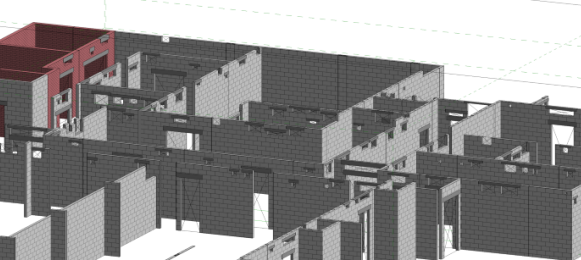The UK construction sector faces a difficult future as it tries to deal with significant skills shortages that threaten to impede growth and sustainability. However, it is also simultaneously undergoing a digital transformation, presenting a unique opportunity to attract younger talent, writes Ryan Donoghue of AJ Digital, one of the country’s leading suppliers of digital services to the construction industry.
The construction sector is integral to the UK's economy, contributing approximately 6% of Gross Domestic Product (GDP) annually, but it faces a pressing challenge – a substantial shortage of skilled workers. Recent data reveals that there are over 35,000 job vacancies in the industry, with more than half remaining unfilled due to a lack of required skills - the highest rate among all sectors within the UK.
A Perfect Storm of Challenges
The industry is facing a perfect storm with several factors contributing to skills shortages. One of the main reasons is because a significant portion of the construction workforce is nearing retirement, leading to a loss of experienced professionals. This is compounded by the fact that the industry struggles to attract new talent, with apprenticeship starts averaging 31,000 per year over the last five years, accompanied by a dropout rate exceeding 40%. Add on challenges such as Brexit and COVID-19, which have exacerbated the shortage by reducing the availability of foreign labour – and we have a crisis.
Projections indicate that an additional 251,500 construction workers will be needed by 2028 to meet the anticipated demand. This shortfall poses a significant threat to the UK's ambitions, including building 1.5 million homes and retrofitting existing ones to meet tight decarbonisation goals – so how will digital construction help?
The Role of Digital Construction
Digital construction refers to the use of technology to enhance the planning, design, delivery and management of built assets. It encompasses tools such as Building Information Modelling (BIM), drones, robotics, AI, and VR/AR training, all of which offer strategic benefits that can directly support workforce challenges.
Making Projects More Efficient
Technologies such as BIM, drones and automation streamline processes, reduce reliance on manual labour, and enable teams to deliver projects faster and more accurately. This not only improves overall productivity but also helps to alleviate some of the pressure caused by labour shortages.
If adopted more widely, these technologies can reshape how projects are delivered, unlocking more efficient processes across the project cycle while opening new roles and opportunities.
Learn more about our 3D Modelling services
Appealing to a New Generation
In addition, virtual reality (VR) and augmented reality (AR) are emerging as rapidly growing niches within Digital Construction, offering innovative ways to enhance project delivery and workforce development. These technologies provide immersive training experiences, allowing new entrants to acquire practical skills in a controlled, risk-free environment. Beyond training, VR and AR are being used to visualise complex design data on-site, support remote collaboration, and improve decision-making through real-time spatial context. As adoption continues to rise, they are becoming valuable tools for improving communication, stakeholder engagement, and overall project coordination.
So, we can see that digital innovation plays a crucial role in addressing skills shortages, making the construction industry more attractive to young people. It means we now have opportunities to showcase the use of cutting-edge technologies like AI, drones and VR in construction that can alter the perception of the industry from being labour-intensive to tech driven.
Investing in Education and Career Pathways
Collaborating with educational institutions to integrate construction technology into curricula can also spark interest among students. For instance, we have specialised courses at Exeter College which aims to equip students with skills needed for modern construction roles. Developing apprenticeships that focus on digital construction skills can also provide hands-on experience and a clear career pathway for young people. In addition, emphasising the role of construction in creating sustainable and smart cities can attract an environmentally engaged younger generation interested in making a positive impact.
Government initiatives and industry responses
Recognising the severity of the skills shortage, the UK government has pledged £600 million to tackle the issue. This investment aims to support the construction of 1.5 million homes by 2029 and stimulate economic growth. Most importantly, the funding allocation also includes £165 million for construction courses to be offered in colleges, £100 million for upskilling workers and £32 million from the Construction Industry Training Board (CITB). Collectively, this will fund over 40,000 industry placements annually.
These efforts are also expected to train up to 60,000 skilled workers, including bricklayers and engineers, by 2029. Additionally, organisations like the Royal Institution of Chartered Surveyors (RICS) are working to diversify membership and improve pathways into the profession, especially for those who cannot afford traditional university routes.
Barriers Still Remain
However, while digital construction adds to this initiative, several challenges must be addressed. Some industry professionals are still hesitant to adopt new technologies, necessitating comprehensive training and a change in management strategies. Implementing digital tools also requires upfront investment, which can be a barrier for small and medium-sized enterprises (SMEs). We also need to ensure that the workforce is equipped with the necessary digital skills to utilise new technologies effectively.
A More Resilient, Tech-Driven Future
The UK construction sector stands at a turning point. While the skills shortage poses a real and pressing threat, embracing digital construction offers a clear and sustainable path forward.
By integrating cutting-edge technologies, fostering collaboration with education, and aligning with government investment, the industry can attract the next generation of talent, improve efficiency, and futureproof itself against further disruption.
Just imagine what the future holds as construction continues to evolve, digitally, intelligently, and sustainably.
Want to learn more about how we support digital transformation in construction? Explore our services or get in touch.



